Content
- The reasons for the development of streptoderma in adults
- How does streptoderma begin?
- Symptoms
- Forms of streptoderma in adults, type and location of rashes
- Streptococcal impetigo
- Bullous impetigo
- Streptococcal seizure or slit impetigo
- Streptococcal diaper rash
- Tourniole (superficial panaritium)
- Ektima vulgar
- Similar diseases, what can be confused with streptoderma?
- Pyoderma
- Herpetic eruptions
- Thrush or candidiasis
- Allergy symptoms
- Chickenpox
- Is streptoderma contagious
- Diagnostics
- Treatment
- Antiseptics
- Ointments and topical preparations
- Antihistamines
- Immunotherapy
- Antibiotic drug treatment
- Folk remedies
- What complications can arise?
- Reasons for relapses and complications
- Video about streptoderma
Streptoderma - dermatological pathology, which is manifested by purulent rashes and blisters on the skin. It is more common in children because the baby's skin is more susceptible to infections. In adults, pathology usually occurs against the background of other skin diseases that reduce local immunity. In the photo, the lesion of the skin at the initial stage looks like bubbles filled with liquid. The disease causes psychological discomfort, and in some cases it causes temporary disability.
The reasons for the development of streptoderma in adults
The cause of the development of the disease is beta-hemolytic streptococcus, which affects damaged skin. The microorganism is normally present on the skin in small quantities, and under certain conditions it begins to actively multiply, provoking the onset of a pathological process.
Predisposing factors for the development of pathology:
- damage to the skin (the presence of abrasions, cracks in the skin);
- decreased immunity;
- stress;
- endocrine pathologies;
- chronic skin diseases (dermatitis, psoriasis, scabies);
- vitamin deficiency;
- insufficient or excessive hygiene;
- impaired blood flow;
- changes in skin pH;
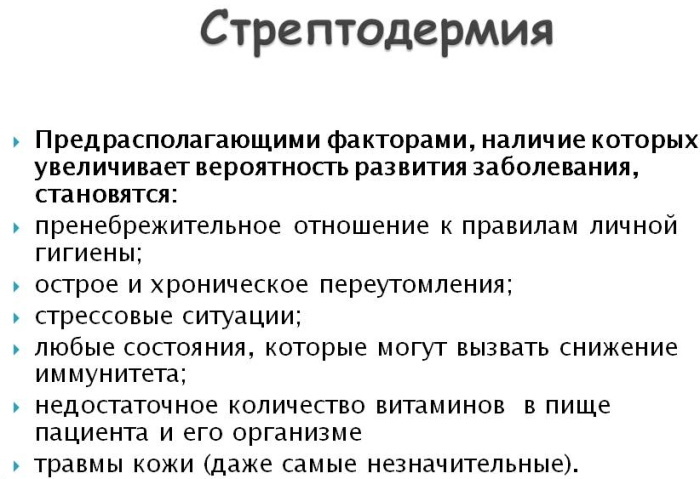
- imbalance of hormones.
How does streptoderma begin?
Streptoderma in adults (the photo allows you to assess changes in the skin) begins suddenly. The skin turns red in certain areas, after 2-3 days bubbles filled with liquid appear, which is accompanied by severe itching. Bubbles burst, erosion occurs, covered with crusts. When scratching damaged skin, the pathological process spreads to other areas.
Possible skin damage in the area:
- nasolabial triangle;
- neck;
- back;
- brushes;
- shins;
- stop.
The rash is also found in the folds under the chest, under the arms, in the groin area.
Symptoms
The main signs of the disease:
- flaky, rounded redness;
- bubbles (flickens) filled with liquid;
- severe itching;
- swelling of the affected area;
- deterioration in general well-being (lethargy, weakness, a slight increase in temperature);
- enlarged lymph nodes.
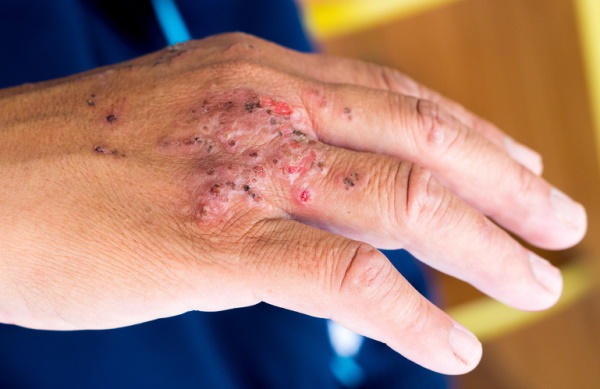
Streptoderma in adults on the hand
The advanced form of the disease is characterized by:
- large ulcerations, covered with a dense crust. After they heal, noticeable scars remain;
- the rapid spread of the pathological process throughout the body with the formation of streptoderma foci merging with each other.
Forms of streptoderma in adults, type and location of rashes
Streptoderma in adults (the photo allows you to distinguish the forms of the disease) has several varieties, depending on the depth of the lesion of the skin, signs and nature of the course.
Streptococcal impetigo
This form of the disease occurs most often. It is characterized by the appearance of small red spots on the skin, which after a while transform into blisters. Blisters may dry out and flake off or burst to form dry crusts. Most often, rashes appear on the cheeks, lower jaw, near the mouth. In rare cases, a rash occurs on the trunk.
Bullous impetigo
This type of disease is characterized by the appearance of multiple blisters up to 3 cm in size. Rashes affect the back of the hands, feet, and may occur on the legs. The patient's general condition is disturbed, the temperature rises, the risk of septic complications increases.
The bubbles burst, leaving behind erosion, which gradually increases. This can lead to the transition of the disease into a chronic form. In this case, extensive areas of the skin are affected, forming zones delimited from the surrounding tissues by rims of exfoliating skin. Inside the lesions, the skin is covered with yellow crusts.
Streptococcal seizure or slit impetigo
Provoking factors that contribute to the development of this form of pathology:
- the habit of licking your lips;
- Difficulty nasal breathing. At the same time, in a patient who is forced to breathe through the mouth, the corners of the mouth are excessively moistened.
Bubbles with liquid inside form in the corners of the mouth. They quickly burst, after which erosion remains with contours of exfoliated skin and a crack inside, covered with a crust.
Streptococcal diaper rash
The rash is localized in the folds of the skin with high humidity (under the breast, in the groin area, behind the ears, in the intergluteal fold, under the armpits). Most often, overweight people suffer.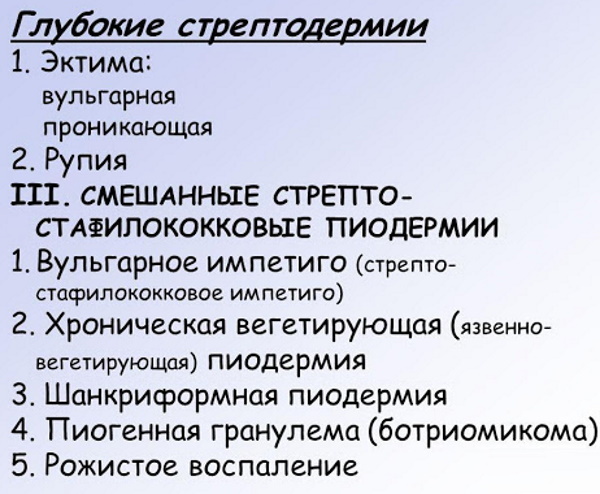
Streptoderma in adults occurs due to rubbing with clothes, insufficient hygiene. This leads to redness, swelling of the skin. If there is no treatment, blisters develop. Multiple small bubbles quickly open up to form a continuous ulcerated, weeping surface with a clear outline, which can be seen even in the photo. Painful cracks appear on the skin, a fungal infection may join.
Tourniole (superficial panaritium)
With this form of the disease, the periungual plates are affected.
Factors that increase the risk of developing pathology:
- burrs;
- finger injuries;
- sloppy manicure.

Bubbles filled with liquid appear around the nail. The pathological process is accompanied by redness, swelling, soreness of the nail phalanx. Blisters burst with the formation of erosion, possibly rejection of the nail plate. With a severe course, the patient suffers from chills, fever, inflammation of the lymph nodes.
Ektima vulgar
The disease is accompanied by the formation of a deep pustule, which is most often localized on the legs.
Usually people with reduced immunity suffer, which is a consequence of:
- vitamin deficiency;
- exhaustion;
- chronic somatic pathologies;
- alcoholism.
The likelihood of the development of pathology increases with non-compliance with the rules of hygiene, the presence of chronic skin diseases.
There are two stages of the disease:
- pustular;
- ulcerative.
First, a painful nodule appears in the thickness of the skin with a purulent pustule that spreads inward. In this case, a grayish-brown crust is formed. After about 1 month, scarring of the skin occurs. In severe cases, the area of inflammation around the crust expands with the formation of a multilayer crust. After its rejection, an ulcer appears, at the bottom of which there is a purulent plaque.
Similar diseases, what can be confused with streptoderma?
Streptoderma in adults (photos of a rash in some skin diseases are similar) may visually resemble other skin diseases. A visit to a doctor in the presence of suspicious symptoms is mandatory, as improper treatment can lead to the development of complications.
Pyoderma
Pyoderma is the general name for purulent-inflammatory skin diseases caused by various pathogens. One of its types is streptoderma, the development of which is promoted by streptococcus. However, the disease has its own characteristics that distinguish it from other types of pyoderma. The causative agent of the pathology, due to its specific features, forms a transparent, not purulent fluid, and the blisters that appear on the skin are more reminiscent of viral rather than bacterial.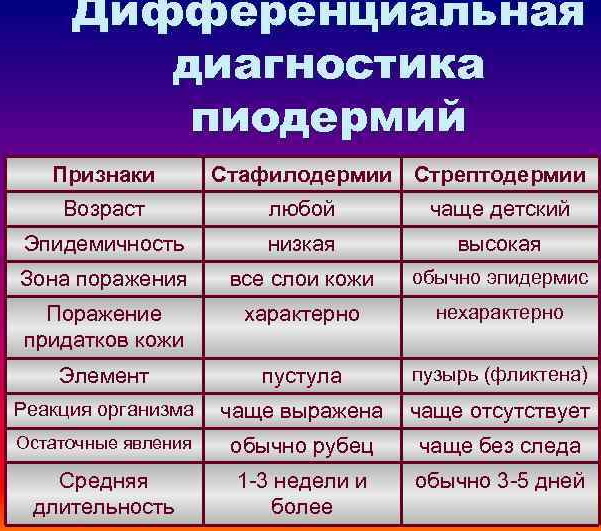
Vulgar impetigo and pyoderma are more similar. They have the same manifestations, the therapy is also identical. Thorough diagnostics with determination of the type of pathogen is important, which will help to choose the right medication.
Herpetic eruptions
Herpetic eruptions on the lips are often confused with streptococcal seizure.
However, there are differences:
- a rash with herpes occurs on unchanged areas of the skin, while rashes with streptoderma appear on the previously damaged skin;
- herpetic rash lasts longer, after opening the bubbles, cracks do not remain;
- with streptoderma, the patient suffers from itching after the rash appears, and with herpes, discomfort is felt even before they occur.
Thrush or candidiasis
With candidiasis of the mouth, which can affect the corners of the lips, deeper cracks occur.
At the same time, there are other symptoms characteristic of this disease:
- white pinpoint rash on the mucous membrane;
- white bloom;
- ulceration on the mucous membrane.
Allergy symptoms
With allergies, bubbles with a clear liquid may appear on the skin, resembling a rash with streptoderma. But the difference is that allergic rashes turn pale when pressed. With streptoderma, the color of the rash does not change.
Chickenpox
The chickenpox rash spreads all over the body. The pathological process can even affect the oral cavity. But every day the rashes decrease.
Since the first elements of the rash appear on the face and head, the disease can be confused with streptoderma. But with chickenpox, other symptoms characteristic of this pathology very quickly arise, which makes it possible to make an accurate diagnosis.
Is streptoderma contagious
Streptoderma is a contagious disease and is transmitted by:
- by contact method. With direct close contact with an infected person (hugs, kisses);
- contact and household. You can get infected through shared utensils, clothes, toys or underwear;
- airborne. Infection in this way is rare. The pathogenic microorganism gets on the skin when an infected person coughs and sneezes.
The incubation period lasts 2-10 days. If the disease develops during infection from a sick person, then it has a more active and aggressive course, proceeds for a long time and in severe form. Often, the disease takes the form of an epidemic.
Most susceptible to the development of pathology:
- children attending preschool and school educational institutions;
- those who do not follow the rules of personal hygiene;
- patients with chronic dermatological diseases;
- patients prone to frequent otitis media, rhinitis;
- people with reduced immunity.
Diagnostics
Streptoderma in adults (photos on the network cannot be used for self-diagnosis) requires a mandatory visit to a doctor, since the disease is dangerous for its complications. If you experience unpleasant symptoms, you need to consult a dermatologist for an accurate diagnosis. The doctor will take a history, listen to the patient's complaints, and conduct a visual examination to assess the type and location of the rash.
You will also need a bacteriological study of the contents of fliken. Using this method, the causative agent of the disease and its sensitivity to antibacterial agents are determined.
Additionally, blood tests may be required:
- general and biochemical;
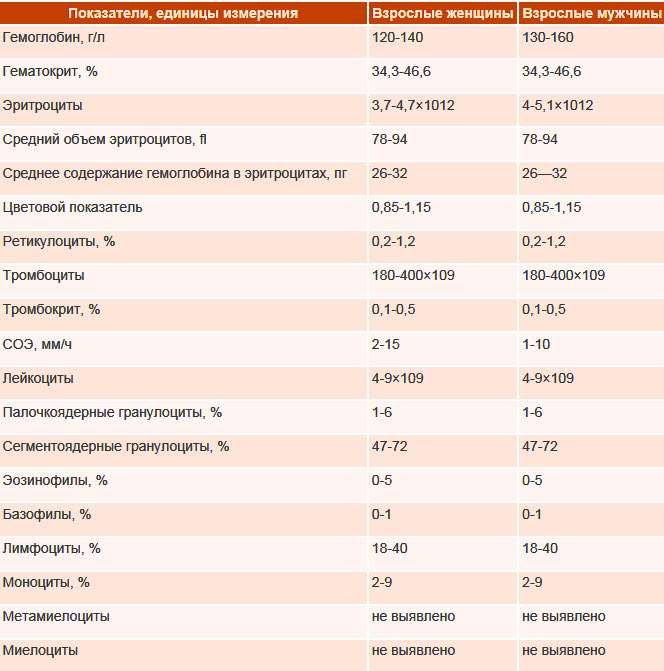
- on the level of thyroid hormones;
- to the Wasserman reaction (determines the presence of syphilis);
- for HIV.
Treatment
Disease therapy is complex with the use of local and systemic (if necessary) drugs. The choice of a treatment regimen depends on the form of the disease, the severity of the course, the presence of complications and the state of the patient's immune system.
Treatment goals:
- eliminate the cause of the disease;
- eliminate predisposing factors (eliminate foci of chronic infection, normalize carbohydrate metabolism, increase immunity);
- prevent the spread of the pathological process to healthy areas of the skin.
The speed of recovery is influenced by:
- the age of the patient;
- the severity of the disease;
- individual characteristics of the human body;
- accompanying illnesses.
To increase the effectiveness of therapy and accelerate recovery, it is recommended:
- stay at home until complete recovery. This will help eliminate the likelihood of infecting other people;
- exclude the use of common household items (dishes, towels, linen);
- do not take a shower or bath. Only wet wiping of the skin is allowed, since water procedures contribute to the spread of infection;
- change bed linen every 2-3 days;
- wear natural fabrics to avoid excessive sweating, change underwear every day.
Antiseptics
Local therapy of the disease involves the use of antiseptic agents, which can slow down its development. The drugs are applied to the affected areas, and the skin around them is also treated to prevent the spread of infection.
Recommended use:
- brilliant green;
- methylene blue;
- potassium permanganate;
- hydrogen peroxide;
- salicylic alcohol;
- fukortsin.
Skin treatment is carried out 2-4 times a day, the product is applied with a cotton swab. In 20 minutes. you can use an ointment or apply a compress to the affected area.
Ointments and topical preparations
Streptoderma in adults (photos after applying local remedies prove the effectiveness of such therapy) requires the use of ointments and other external drugs. They prevent the multiplication of pathogenic microorganisms, accelerate tissue repair, and prevent the spread of the disease throughout the body.
Means for topical use for streptoderma:
| Name | Action and efficiency | How to use | Price |
| Antiseptic ointments | |||
| Zinc | Quickly eliminates the manifestations of the disease. Dries skin, regenerates tissue, eliminates redness and irritation. | Apply to previously cleansed skin with a thin layer 1-3 times a day. | From 18 rubles. |
| Salicylic | It has antiseptic properties, suppresses the inflammatory process, disinfects, accelerates healing. | Apply 1-2 times a day. Can be used under a gauze bandage for significant skin lesions. | From 23 rub. |
| Salicylic zinc | Eliminates redness and inflammation, promotes skin regeneration. | Apply 1-2 times a day to the affected areas of the skin, having previously treated them with an antiseptic. | From 14 rubles. |
| Streptocidal | Possesses pronounced antimicrobial properties, suppresses the reproduction of the pathogen. | Apply to the affected area with a thin layer. The duration of application and the number of applications depend on the severity of the disease. | From 44 rubles. |
| Sulfur | Possesses antimicrobial and antiparasitic action, activates blood flow, softens, restores the skin, promotes its healing. | After cleaning the skin, apply the product, rubbing it in for 10 minutes. Leave for a day. | From 19 rub. |
| Vishnevsky | Has a safe composition, has an antiseptic effect, destroys the pathogen. By activating blood flow, it improves tissue nutrition. | Use 2 times a day. Apply under the bandage, fixing it well. | From 28 rubles. |
| Ichthyol | Disinfects, destroys the pathogen, eliminates inflammation, relieves itching. | Apply 2 times a day to previously cleansed affected areas. | From 125 rub. |
Antibiotic ointment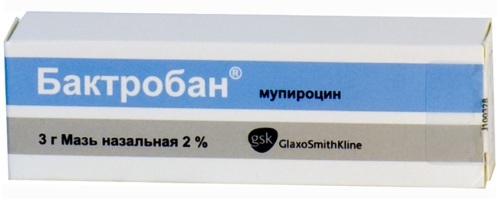 | |||
| Hyoxysone | Combined remedy, relieves the inflammatory process, destroys the pathogen, relieves itching and rash. | Apply to the skin 1-3 times a day. | From 50 rubles. |
| Bactroban | The drug is effective against various microorganisms, prevents their reproduction, relieves rash and redness. | Apply to cleansed skin 3 times a day. | From 774 rub. |
| Baneocin | Fights infection, destroys streptococci, eliminates the manifestations of the disease. | Apply to the previously cleansed affected area 3 times a day. | From 209 rub. |
| Erythromycin ointment | Used in extreme cases due to the likelihood of side effects. The tool relieves inflammation, itching, normalizes the activity of the sebaceous glands, destroys bacteria. | Apply to the affected area 3 times a day. | From 84 rub. |
| Tetracycline ointment | It has a wide spectrum of action, is effective against various pathogens, including streptococcus. Differs in fast action. | Use once a day under a gauze bandage. | From 22 rub. |
| Synthomycin ointment | Has antibacterial and healing properties, relieves signs of disease in 7 days. | Apply a thin layer to the affected areas, cover with a bandage, which is changed after 1-3 days. | From 60 rubles. |
Antihistamines
Antihistamines are prescribed only if there is unbearable itching. It is recommended to use third-generation drugs that have a minimum number of side effects (Claritin, Zyrtec, Terfenadine).
Immunotherapy
With a protracted course of the disease, intramuscular administration of immunomodulatory drugs is recommended:
- Pyrogenal. Enter once a day. It may take 10-15 injections, which are given every other day;
- Neovir. The agent is administered every other day, one course consists of 5-7 injections;

- Levamisole. The drug is used daily for 3 days. After a break of 5 days, treatment can be resumed.
Such funds are distinguished by desensitizing and anti-inflammatory properties, and help to increase immunity.
Antibiotic drug treatment
Severe forms of the disease require the use of systemic antibacterial drugs.
The drugs of the penicillin group are used, to which the pathogen is most sensitive:
- Ampicillin;
- Amoxiclav;
- Amoxicillin.
If it is impossible to use them, cephalosporins are prescribed:
- Suprax
- Cephalexin.
The use of macrolides is also effective:
- Azithromycin;
- Erythromycin;
- Klacida.
In some cases, funds from different groups are combined on the recommendation of a specialist.
Folk remedies
Folk remedies are used only as part of complex therapy.
Lotions from:
- decoction of oak bark. Dry raw materials (3 tbsp. l.) Pour hot water (2 tbsp.), cook over low heat for 30 minutes. The cooled and strained broth is used as lotions;
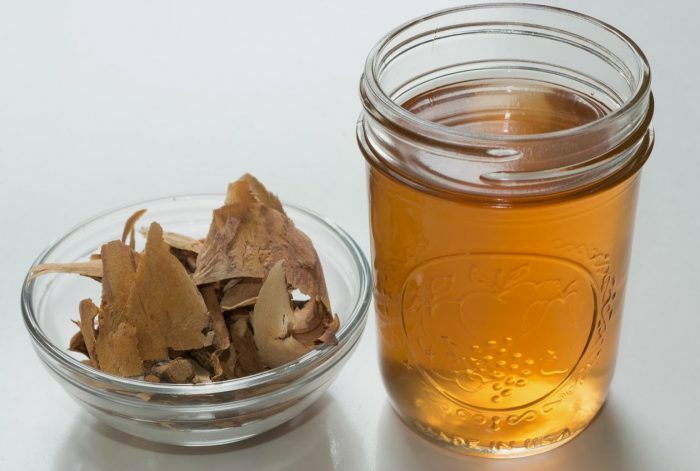
- infusion of chamomile. Flowers (1 tbsp. l.) pour hot water (1 tbsp.), insist 30 minutes;
- broth of sage. For preparation of means 1 tbsp. l. plant leaves are poured with hot water (1 tbsp.), boiled over low heat for 10 minutes. Allow the product to cool and filter;
- infusion of the sequence. Dry raw materials (2 tbsp. l.) Pour hot water (500 ml), insist 1 tsp.
Inside it is useful to use:
- rosehip infusion. Berries (4 tbsp. l.) pour 500 ml of boiling water into a thermos, insist overnight. Take 50 ml before meals 3 times a day;
- tea from currant, raspberry leaves with lemon;
- aloe juice. The tool is taken 2 times a day before meals for 1 tsp. l.
What complications can arise?
Timely treatment allows you to get rid of the signs of the disease in 7 days. If there is no therapy, then the disease spreads, affecting new areas of the skin. Neglected cases require hospital treatment.
Long-term presence of the disease increases the risk of developing:
- microbial eczema;
- scarlet fever;
- bacterial blood damage;
- post-streptococcal glomerulonephritis;
- teardrop psoriasis;
- rheumatism;
- myocarditis;
- boils and phlegmon.
Reasons for relapses and complications
Recurrences are caused by improper or insufficient treatment. You can not stop therapy when signs of improvement appear, you must complete the entire course, following the recommendations of a specialist. Even if these conditions are met, the disease can recur in people with weakened immunity. In this case, an integrated approach and a well-thought-out therapy regimen will help.
Streptoderma in adults is not as common as in children. The reason is that the immune system of an adult is more active and strong. Despite this, the risk of catching an infection is still present, especially in people with endocrine, hormonal disorders, who are subject to regular stress. The disease usually does not cause severe physical discomfort, but the elements of the rash look repulsive even in the photo, which significantly reduces the patient's self-esteem. Timely and adequate treatment helps to improve the appearance of the skin and get rid of severe complications.
Video about streptoderma
Malysheva about streptoderma:



